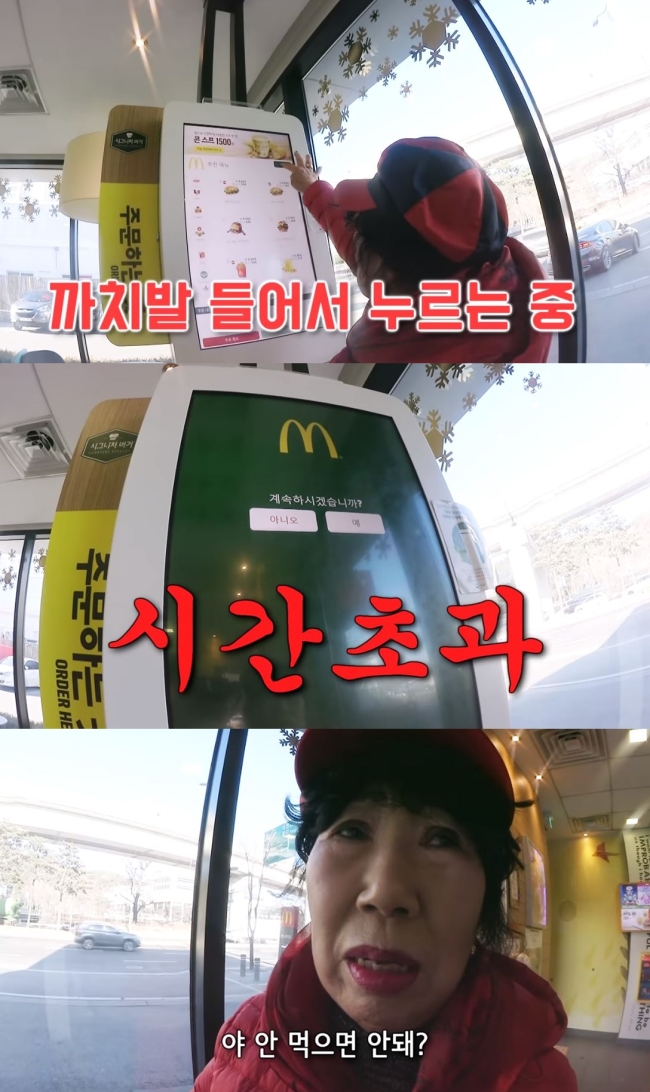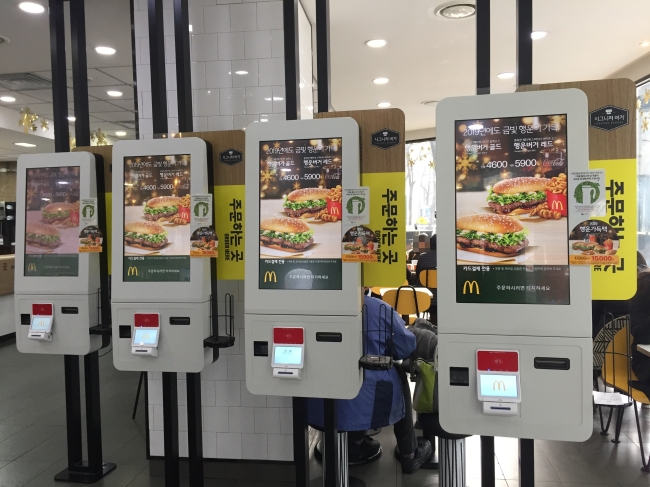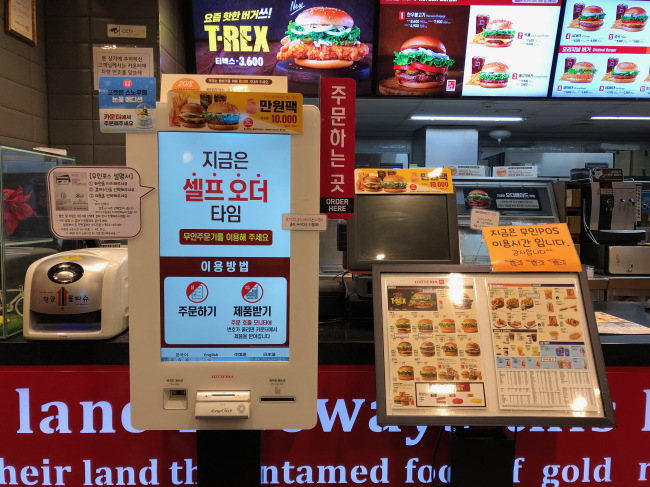[Feature] ‘Smart’ restaurants challenge for elderly
Elderly customers face difficulties with self-ordering kiosks
By Park Ju-youngPublished : Feb. 13, 2019 - 15:02
When 71-year-old YouTuber Park Mak-rye tried a fast-food restaurant’s self-ordering service for the first time, the challenging process took longer than anticipated to complete.
Park first pushed the “order” button on the screen, then slowly read the menu’s tiny letters and scrolled down. As she struggled to find the bulgogi burger combo she wanted for lunch, the ordering session reached its time limit.
“What’s wrong with this machine?” Park shouted, saying she would never use the kiosk again.
Park first pushed the “order” button on the screen, then slowly read the menu’s tiny letters and scrolled down. As she struggled to find the bulgogi burger combo she wanted for lunch, the ordering session reached its time limit.
“What’s wrong with this machine?” Park shouted, saying she would never use the kiosk again.

The eight-minute video titled “The Restaurant That Mak-Rye Can’t Go To,” got over 400,000 views on YouTube in one month, garnering over 2,000 comments that mostly criticize the machine for being difficult to use.
The installation of self-ordering kiosks has been spreading across the country, especially after the minimum wage hike hit hard in 2019. Under President Moon Jae-in’s income-led growth policy, the minimum wage has risen from 7,530 won ($6.70) per hour in 2018 to 8,350 won in 2019.
According to a survey conducted by the Korea Federation of Micro Enterprise in December 2018, about 1 in 5 workplaces said they had reduced the number of employees following the rise in minimum wage.
Some short-staffed stores have been installing self-ordering kiosks instead.

“The demand (for the machines) has been increasing since we started the business in 2011, but orders have exploded since December 2018, which seems to be related to the recent minimum wage hike,” Ahn Ho-seong from Payself, a kiosk manufacturer, told The Korea Herald.
Restaurant and cafe owners are the main customers, but hospitals, cyber cafes and study centers also deploy the machines to save on labor costs.
The rate at which the machines are being installed is especially high at fast-food outlets.
As of Jan. 1, Lotteria had such kiosks at 826 of its 1,350 stores nationwide, while McDonald’s operated the machines at about 250 of its 420 stores.
“McDonald’s has deployed the self-ordering kiosks since 2016, as part of efforts to change restaurants into ‘futuristic stores’ and to offer better service to customers by reducing their waiting time during busy hours,” a PR manager from McDonald’s Korea told The Korea Herald.
The fast-food chain said the self-ordering machines have a magnifier function and display adjustment for customers who struggle with placing orders.

Many elderly customers, however, were seen having difficulties ordering via the machines at the restaurants.
“I’ve been trying to buy a burger combo (through the machine), but it’s not as easy as it seems,” Chang Soo-young, 81, said while using the self-ordering machine at a restaurant near Seoul City Hall.
“I can’t read the small letters on the menu very well, and it’s hard to find the burger combo I want on the screen. It’d be much simpler and faster if I just ordered it through a cashier.”
While two other customers in their 20s and 30s finished ordering at machines next to her, Chang was struggling.
Another senior customer at a fast-food restaurant at Seoul Station said his heart beat fast as he ordered coffee through the self-ordering machine.
“The ordering process is complicated, people are waiting behind me in a long line, but I can’t find where to put my credit card. All these things just freaked me out,” the customer in his 80s said.
“It’s kind of sad when thinking that the world is changing very fast and I’m left behind. It’s frustrating, and it hurts my pride.”
The customers also need to check a monitor to see if their orders are ready.
In November 2018, a man in his 40s threw a burger at a cashier’s face, upset about the food being served late. The cashier said the order number was displayed on the monitor, but the customer argued he couldn’t see it.
Senior customers’ struggles sometimes impact stores’ operations as well.
“Our store installed self-ordering machines to reduce labor costs, but, ironically, I had to hire more part-time workers to assist elderly customers in using the machines,” an owner from an eatery told The Korea Herald.
The store is located in the heart of Jongno, a popular hangout for the elderly in central Seoul. The elderly customers account for 20 percent of the store’s sales, the owner said.
“Customers in their 50s at least try to use the self-ordering machine. About 90 percent of elderly customers, however, walk straight to the counter, throw 1,000 won at the staff, and then say, ‘Just give me a cup of black coffee.’ Many of the elderly people know the existence of the kiosk, but they often say that they used it at fast-food restaurants but failed to order correctly.”

Repeated failure at using the high-tech ordering service can impair one’s self-reliance and result in depression, an expert said.
“The feeling of being left behind can make old people feel depressed and degrade the quality of their life,” Chung Soon-dool, a social welfare professor at Ewha Womans University, told The Korea Herald.
“It also can make old people believe that the world is changing in favor of young people, which can lead to generational conflicts.”
To solve the problem, the professor stressed the importance of educating seniors to help them adapt to a more tech-savvy society.
“Education sessions should teach the old how to use the self-ordering screens. A little help from the staff, such as letting them order in an analog way, would be needed sometimes (while the elderly get used to the technology).”
On her way back home, the elderly YouTuber Park gave her friend a few tips for using the self-ordering system.
“If you want to place an order through a self-ordering screen, you should bring your reading glasses, a chair (in case you can’t reach the top of the screen) and a credit card as the machine doesn’t take cash!” Park said.
By Park Ju-young (jupark@heraldcorp.com)







![[KH Explains] Hyundai's full hybrid edge to pay off amid slow transition to pure EVs](http://res.heraldm.com/phpwas/restmb_idxmake.php?idx=644&simg=/content/image/2024/04/18/20240418050645_0.jpg&u=20240419100350)






![[From the Scene] Monks, Buddhists hail return of remains of Buddhas](http://res.heraldm.com/phpwas/restmb_idxmake.php?idx=652&simg=/content/image/2024/04/19/20240419050617_0.jpg&u=20240419175937)

![[KH Explains] Hyundai's full hybrid edge to pay off amid slow transition to pure EVs](http://res.heraldm.com/phpwas/restmb_idxmake.php?idx=652&simg=/content/image/2024/04/18/20240418050645_0.jpg&u=20240419100350)

![[Today’s K-pop] Illit drops debut single remix](http://res.heraldm.com/phpwas/restmb_idxmake.php?idx=642&simg=/content/image/2024/04/19/20240419050612_0.jpg&u=)